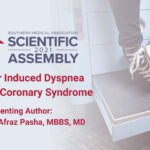Abstract | November 8, 2021
Ticagrelor Induced Dyspnea after Acute Coronary Syndrome
Learning Objectives
- This case highlights the occurrence of early onset ticagrelor induced dyspnea, which is relatively more common as compared to late onset dyspnea. It leads to decreased compliance with guideline directed dual antiplatelet therapy, thereby increasing the risk of in-stent thrombosis.
- The commonly postulated hypothesis for ticagrelor induced dyspnea is increased plasma levels of adenosine through inhibition of adenosine deaminase. Alternatively, dyspnea could be due to inhibition of P2Y12 receptors on sensory neurons leading to stimulation of chemoreflex system.
- The PEGASUS TIMI 54 trial has shown lower rate of Ticagrelor induced dyspnea with a dose of 60 mg twice daily as compared to 90 mg twice daily regimen. Additionally, there was no dose related difference on inhibition of P2Y12 receptors.
Introduction: Ticagrelor and elinogrel are oral reversible platelet P2Y12 receptor inhibitors, frequently used in guideline directed management of acute coronary syndromes. As compared to irreversible P2Y12 receptor inhibitors such as clopidogrel and prasugrel, oral reversible inhibitors elicit an adverse effect of dyspnea with a reported incidence of about 13%. This adverse effect is thought to be dose dependent with an uncertain pathophysiology. Incidence is lower with Cangrelor, an intravenous reversible platelet P2Y12 receptor inhibitor. We present a case of ticagrelor induced acute onset dyspnea in a patient who was initiated on ticagrelor following percutaneous coronary intervention (PCI).
Case Presentation: A 54-year-old Caucasian gentleman presented with subacute history of dyspnea, which he characterized as intermittent breath catching episodes. His symptoms started after discharge from recent hospitalization about eight days ago. Dyspnea occurred predominantly during moderate to severe activity and occasionally at rest. There were no associated symptoms of orthopnea, paroxysmal nocturnal dyspnea or pedal edema. Patient was hospitalized ten days ago with acute onset chest pain and was diagnosed to have acute inferior wall myocardial infarction. He underwent balloon angioplasty, followed by 18 hours of eptifibatide therapy with subsequent staged PCI of right coronary artery (RCA) with a drug eluting stent. He was discharged on dual antiplatelets, aspirin and ticagrelor. Patient had past medical history of chronic kidney disease stage III, hypertension, hyperlipidemia, type II diabetes mellitus, obesity and nicotine dependence. His other prescription medications were atorvastatin, lisinopril, carvedilol, nitroglycerin, insulin, sitagliptin, metformin and icosapent ethyl.
On presentation, patient was comfortable and asymptomatic. Initial vital signs revealed blood pressure of 147/89, heart rate of 86, saturation of 99% on room air. On examination, patient had a regular pulse. Cardio-respiratory examination was unremarkable without jugular venous distension. ECG showed normal sinus rhythm without acute ischemic changes. Cardiac biomarkers revealed elevated troponin I of 0.46 ng/mL, which had down trended from previous value of 15.4 ng/mL recorded ten days ago. Chest x ray showed normal lung fields without any infiltrates or congestion. Echocardiogram during last admission showed ejection fraction of 60-65% without regional wall motion abnormality and repeat study was not warranted.
Diagnosis: With recent RCA stenting for acute inferior wall myocardial infarction and risk of in-stent thrombosis, patient’s presentation of dyspnea was initially considered to be angina equivalent warranting treatment with heparin bolus and infusion, as per acute coronary syndrome protocol.
Further trending of troponin I demonstrated a downward trend ruling out an acute coronary event. In the absence of clinical and radiological signs of infection and volume overload, pneumonia and acute congestive heart failure were ruled out. As patient’s reported symptoms were characteristic of cheyne- stokes pattern of breathing, ticagrelor related dyspnea was considered as the most likely cause of patient’s symptoms.
Management: After ruling out an acute coronary event, therapeutic anticoagulation was discontinued. Ticagrelor was discontinued and a loading dose of prasugrel was administered. Patient was discharged on guideline directed therapy for acute coronary syndrome with replacement of ticagrelor with prasugrel. He was advised to follow-up in cardiology clinic within four weeks.

